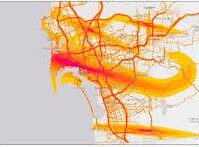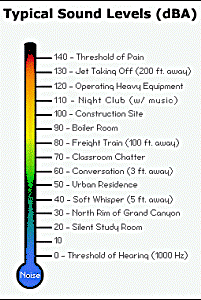
Our distant ancestors would be gobsmacked by the racket enveloping us.
Almost all of us live within a few yards of other people. So we accept modern living accompanied with the random sounds of neighbors living their lives. Even so, most of us also take pleasure in being able to escape from the sounds of the kid with a new set of drums next door, or his dad’s table saw that sounds like it could be a film cue from a Roger Corman film. We accept a steady din as the price of living near others. But when the din turns into something more, we notice. And, at some point, that noise can be an intrusion into what we consider to be our own personal space. The problem is that most people don’t think about their noise footprint.
Traditionally, restaurants and bars have been used as a “third place” for people looking a refuge from work or home. But venues that serve alcohol or cater to group events can now require communication assists via texting or lip-reading. Maybe I need to eat dinner in a place with a better class of people, but I seem to notice more shouting, particularly when members of the same sex congregate. This is not usual, and it is crazy that we accept it.
 In many places incidental or ambient noise hovers at around 45 dB, or the equivalent of several household appliances running. But it can quickly go higher if a person is located in the vicinity of an airport or a busy highway.
In many places incidental or ambient noise hovers at around 45 dB, or the equivalent of several household appliances running. But it can quickly go higher if a person is located in the vicinity of an airport or a busy highway.
Aircraft noise is especially an overlooked pollution source that affects most of us. For example, a helicopter is not just a flying machine, but a ragged noise creator as well. It produces massive and overwhelming waves of variable air pressure, the same physical element our ears were meant to detect at whisper levels. I sometimes wonder if their occupants have any idea of the costs of their preferred form of mobility. Ditto for jet engines, which violently compress air and fuel to produce thrust, with deafening noise and smoke as a byproduct. These airborn sources of noise are especially dangerous because they are unimpeded by natural obsticles.
Our distant ancestors would be gobsmacked by the racket enveloping most of the world’s cities. They might wonder what our children will use for communication as adults when the delicate sensory cells of the inner ear are permanently fried.
There are times when we want to immerse ourselves in the loud enthusiasm of others. Name the sport or a pop concert, and the aural excitement in the space is part of the appeal. Philadelphia’s Citizens  Bank Park has 1400 loud speakers hovering in its packed seven-tier grandstand, enough to encourage any person in love with stillness to escape with a homerun over the center field wall. Granted, no one wants a silent sports venue, or a concert where the reactions of listeners are not part of what should be a contagious and magical experience. But it also seems apparent that some among us are careless in allowing our aural pollution to bleed into another’s personal space. You know the common culprits: fake low-fi bass spilling out of a car and onto nearby streets and sidewalks, or the pretend power represented in noisy after-market mufflers hanging from Honda Civics or Harley Davidsons.
Bank Park has 1400 loud speakers hovering in its packed seven-tier grandstand, enough to encourage any person in love with stillness to escape with a homerun over the center field wall. Granted, no one wants a silent sports venue, or a concert where the reactions of listeners are not part of what should be a contagious and magical experience. But it also seems apparent that some among us are careless in allowing our aural pollution to bleed into another’s personal space. You know the common culprits: fake low-fi bass spilling out of a car and onto nearby streets and sidewalks, or the pretend power represented in noisy after-market mufflers hanging from Honda Civics or Harley Davidsons.
 Perhaps the best explanation for rethinking the intrusion of noise in our lives was offered by Les Blomberg of the Noise Pollution Clearing house, who imagined what it would be like if we could see the trail of noise we leave in our wake. It is a wonderful insight. In this image, the acoustic mess we sometimes make would look like piles of refuse or spattered paint tossed into the paths of others.
Perhaps the best explanation for rethinking the intrusion of noise in our lives was offered by Les Blomberg of the Noise Pollution Clearing house, who imagined what it would be like if we could see the trail of noise we leave in our wake. It is a wonderful insight. In this image, the acoustic mess we sometimes make would look like piles of refuse or spattered paint tossed into the paths of others.
I have a friend and neighbor who constantly gathers the few leaves that fall into his tiny yard, using a noisy and polluting landscaper’s blower. It can be heard all over the neighborhood in the fall, adding to the din that is already raining down by the same 90 dB gas-powered blowers used by the area’s official landscaper. Some progressive cities have banned these aural and toxic polluters. Compulsive leaf-blowing should be its own category in the DSM mental health catalogue.
To be sure, we live less in the natural world than we used to. The transition from car to school to work and home often happens with very few steps in between. These escapes into successive cocoons is a reminder that the sensory equipment of humans must be protected when traveling through ordinary environments. No wonder most of my older friends wear hearing aids.
A lot of us are not willing to sacrifice our fragile hearing to this relatively degraded soundscape. At some point the noise given off by our dubious devices of convenience needs to be tamed to be compatible with unprotected hearing that is our birthright.
____________
For more on sound and noise download a free copy of the book, The Sonic Imperative, available from this site.



